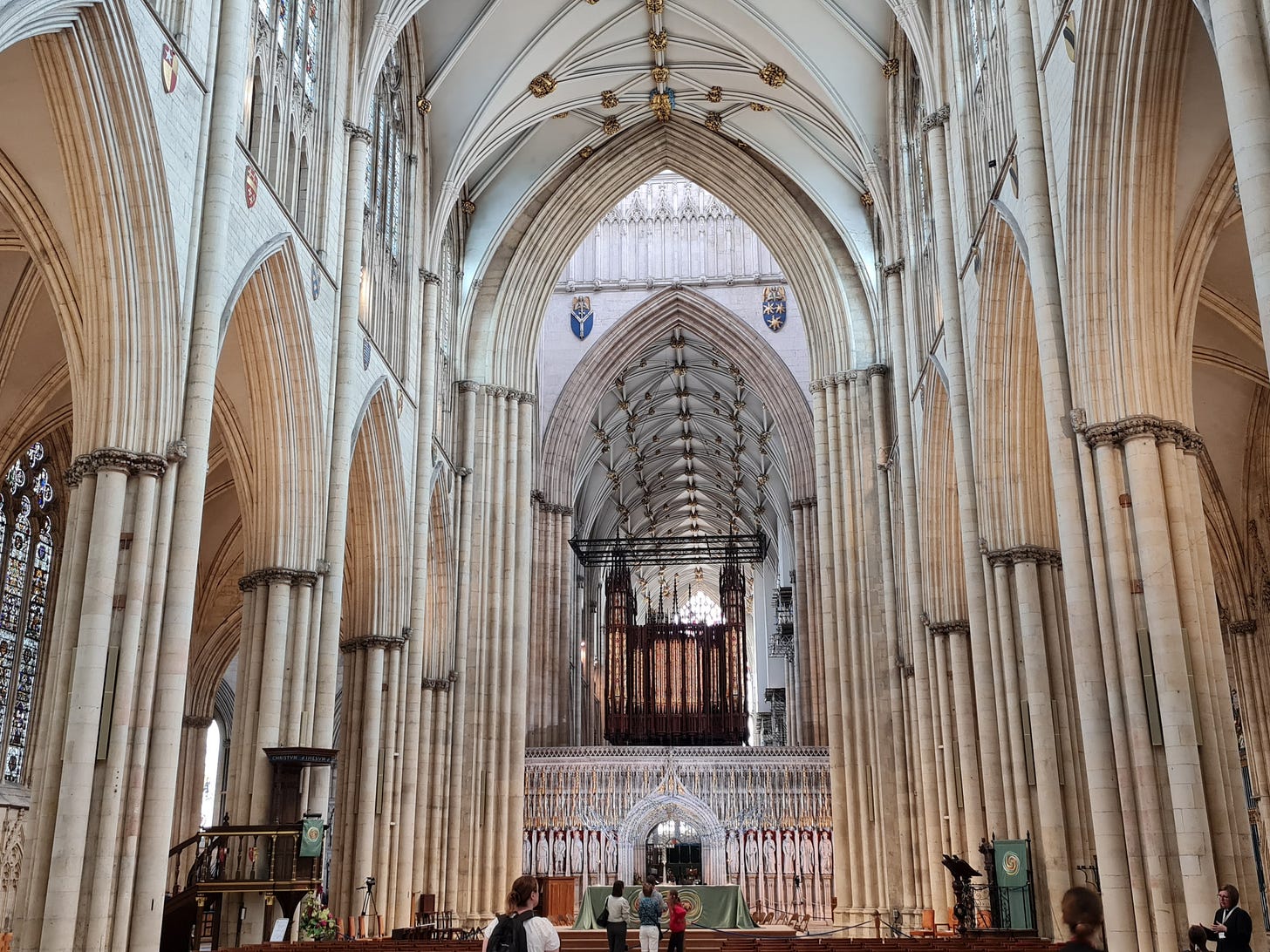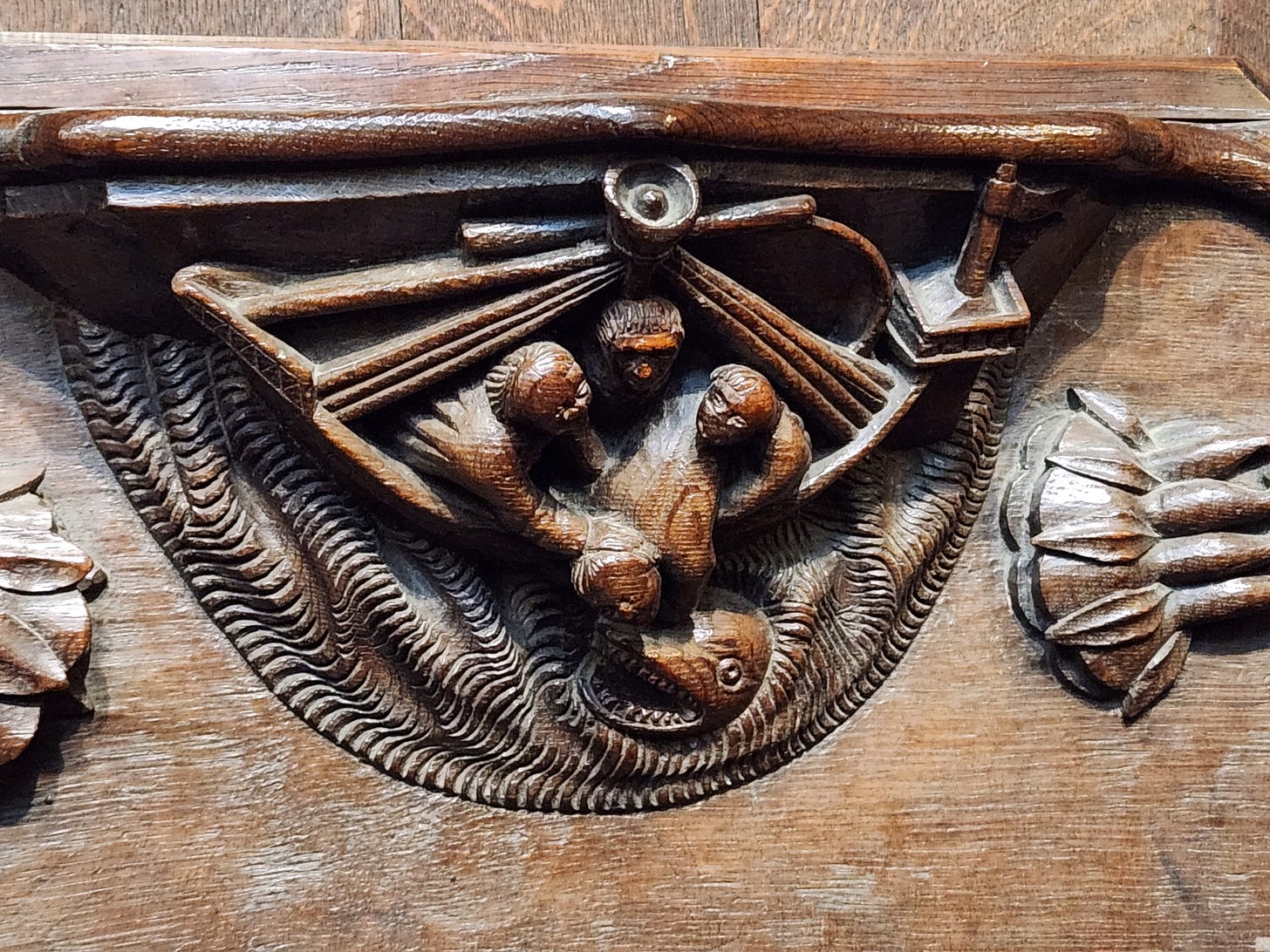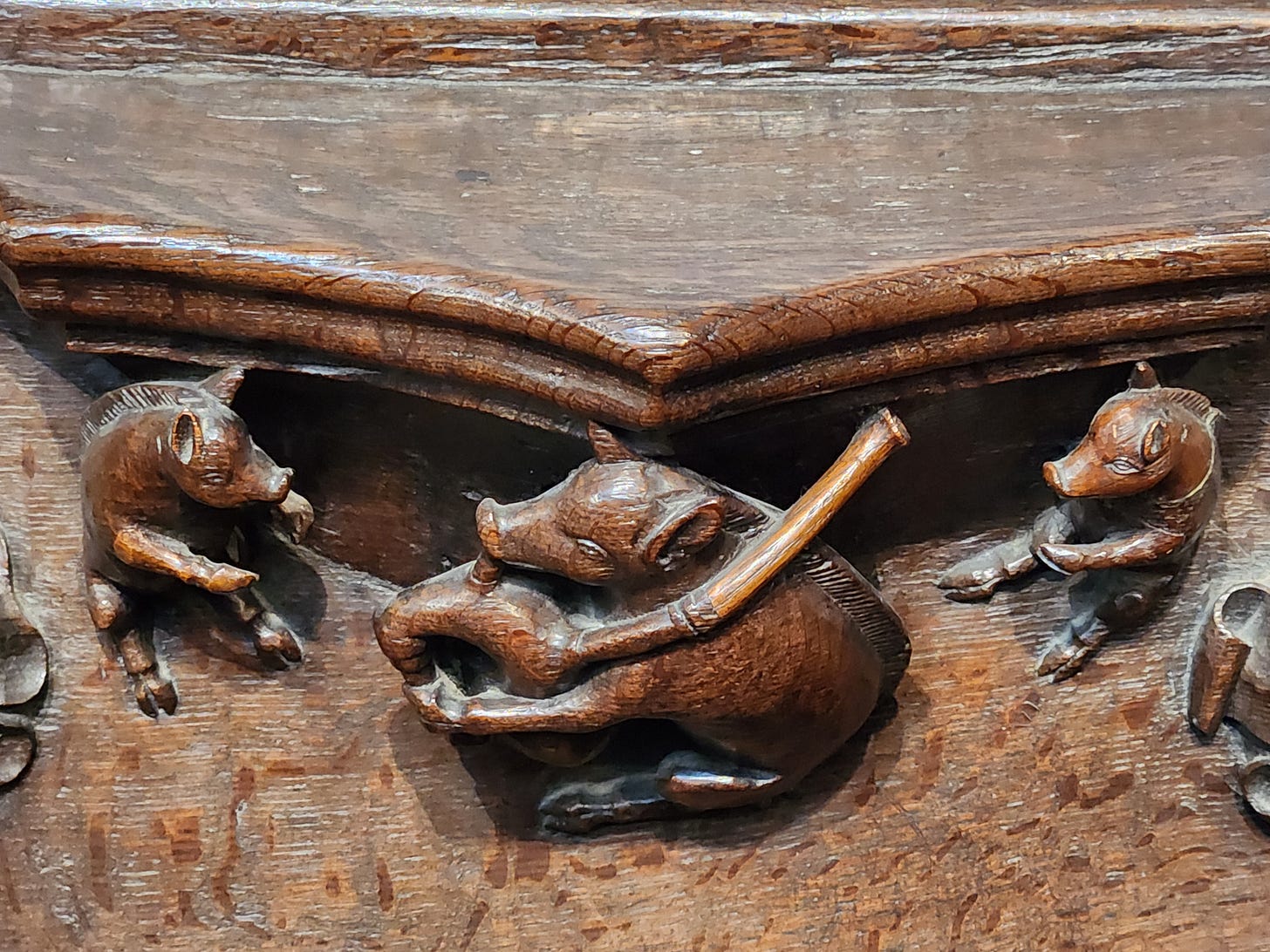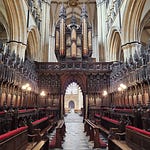The Chancel and the Choir
From primitive times it has been usual to divide the interiors of churches into sections, increasing in sanctity as one advances eastwards. In the outer courts, and for some parts of the services, in the lower portions of the nave, even heretics and heathen were suffered to stand to hear the preaching of the faith. Beyond them, the faithful in full enjoyment of the privileges of the church had their places, but beyond even these lay the sacred enclosure within which only the clergy might enter. This was anciently variously named. It was the bema, a word sometimes meaning the lectern, sometimes the raised bench of seats for the priests, and sometimes the part of the church in which both these were situated; it was the sacrarium or sanctuary, as corresponding with the Sanctum Sanctorum [Holy of Holies] of the older Dispensation; it was the thusiasterion, the place of the altar, the word strictly meaning the altar itself; it was the presbytery, or place of the priests; and yet further it was named adyta, the place inaccessible to the laity. None of these titles have been brought into use among us as descriptive of this section of the Church, although we do employ sacrarium, and less frequently presbytery, to indicate the section within the altar rails. Two other expressions, however, have early authority, and are still familiar to us. The Fourth Council of Toledo, held in 633, in its 17th canon, bids the priests and deacons to communicate before the altar, the clerks or inferior clergy within the choir (in choro), and the people outside the choir. Again, Eusebius of Caesarea, who flourished around 315, tells us that, in the church built by Paulinus, the extremity containing the altar “was divided from the rest by certain rails of wood, curiously and artificially wrought into the form of network, to render it inaccessible to the multitude;” and from this network barrier, of which this is our earliest instance, called in Latin cancelli, we get our modern name chancel.
The idea that the whole congregation has a right to see everything which goes on within the chancel, an idea which has led in not a few cases to the mutilation, or even the destruction of chancel screens, is certainly not primitive, for it was an early custom not only to fence off this sacred enclosure from the approach of the laity, but also to veil it from their gaze. The Eastern Church, the most conservative portion of Christendom, still shuts in the chancel with a solid screen, pierced only by “the holy gates”, which are closed and curtained at the most sublime portions of the holy mysteries. Similarly, Synesius, (about 410), speaks of “the mystical veils”, St Chrysostom (about 398) and Evagrius (about 594) of “the folding doors”, and St Athanasius (about 330) of “the hangings”; all of them referring to the same thing, namely, the screen, impenetrable to the eyes of the people which separated the chancel from the nave. Such ponderous stone screens, pierced only by a central arch for gates, as we see in the cathedrals of York, Lincoln and elsewhere, are so far from being the outcome of “the Dark Ages”, that they are distinctly primitive in idea if not in form.
York Minster nave with the chancel/choir screen beyond
We will not, however, spend time here considering the rood screen and its statuary, the great crucifix with its attendant figures of the Blessed Virgin Mother and St John, beyond saying that in medieval days almost all English churches were provided with this imposing structure, or at least with a beam carrying the three figures, forming a fitting entrance to the most sacred portion of the house of God, and that in not a few churches, both in towns and in villages, its use has now been restored. Beneath this loft, let us pass within the chancel itself.
17th century rood screen at Wakefield (Yorkshire)
During the celebration of divine service, the laity were rigidly excluded from this section of the church, although there is evidence that the right to occupy some part of it was often claimed by the wealthier or the more powerful parishioners. The Constitutions of Bishop Walter of Durham in 1255 bid “rectors and others to prevent laymen from sitting or standing in the chancel during the celebration of Mass unless they be patrons of the churches or unless some vulnerable person be admitted out of respect.” A provincial council in Scotland in 1225 promulgated a canon to this effect, “Let not laymen presume to sit or stand among the clerks about the altar while the holy mysteries are celebrating except our Lord the King and the nobility of the realm.” Again in 1230, among sundry articles of inquiry in the Diocese of Lincoln, it is asked “whether any of the laity persist in standing in the chancel with the clergy.” From the days of the Revolution down to recent times, an era as ignorant of ecclesiastical usages as it was, for the most part, careless of them, the chancels of our churches were in many instances blocked with high pews, which reached almost to the very steps of the altar. We have now substituted almost throughout the country another and far more seemly custom, but one which, in the case of ordinary parish churches, is almost as far removed from the methods of our ancestors. For it is certainly a mistake to suppose that the long lines of white-robed choristers are really a revival of an ancient usage in the bulk of our parish churches. “Choirs and places where they sing” meant, in medieval times, cathedral and collegiate churches, but did not include the ordinary parish churches. The chancel was thus anciently reserved for the exclusive use of the clergy and the assistant ministers at the altar, with the addition, in churches having a capitular body, of such singers as were provided for on the foundation.
The earliest form of chancel terminated in an apse, the altar standing upon the chord of the arc, a throne for the bishop being behind it against the eastern wall, and seats for the clergy filling the curve on either side of the throne. We have traces of such an arrangement in the cathedrals of Canterbury and Norwich, but basilican churches, of which this form of chancel was one characteristic, were never general in this country. It would seem as if, in early times, not much more accommodation was made for the clergy in the chancel than for the laity in the nave; for the recognised name of the priest's places during the choir offices is Stalls, which strictly means standing places and not seats. Standing and kneeling were in fact the only attitudes formally recognised during divine service; sitting was afterwards allowed as a concession rather than a right. The dignity of the bishop has, however, always been marked by the provision of a throne for his use in cathedral churches. In Greece, a T-shaped crutch is allowed to the aged monks to support them during the recitation of the offices, and the introduction of a similar practice in the monasteries of the West was the first departure from the rigour of the original rule, which insisted upon all monks standing throughout their services, except when required to kneel.
The rule once relaxed, the way was open for the gradual development of the stalls with armrests, bookrests, canopies and hassocks as we find them today. In the ninth and two following centuries, we read of forms for the use of the clergy; Maestricht had stalls in 1088; from the 13th to the 15th century, we find ample notices of the adornment of these seats with carvings, hangings, painting and canopies. At first, however, only the higher dignitaries and aged monks were allowed to occupy stalls; deacons and junior monks sat on benches below them, while choristers and Vicars Choral stood or knelt upon the floor. For the due oversight of all the members of the choir, the four persons of highest dignity sat at the four corners; the dean in the westernmost stall on the south side, the precentor in the corresponding one on the north, while the chancellor and the treasurer were similarly placed at the eastern end. Between these sat the other members of the chapter in order of seniority. Frequently the westernmost stalls, to the number of three or four on each side, were returned, that is, turned round so as to face the altar.
Ripon Cathedral Choir stalls (15th century)
In many of our old conventual churches we find a form of seat which was intended to provide a compromise between the standing posture, at first insisted upon for the recitation of the Psalter, and the sitting position, subsequently tolerated. This ingenious arrangement was known as a misericorde, and is sometimes less correctly called a miserere. It consisted of a narrow shelf beneath the seat, so that the latter, which was hinged, having been raised, the occupant of it could rest, half sitting and half standing against the ledge beneath it. There is an early English example in the Lady Chapel at Westminster; and several in different places have attracted some attention from the curious carvings with which they have been adorned. It would almost look as if the monastic artist, having work assigned to him which would seldom meet the eyes of his brethren, and scarcely ever that of the laity (for the misericorde is, as we have pointed out on the underside of the seat, and visible only when that is raised), sometimes gave full liberty - not to say license, to his fancy; and in this way gave us examples of monastic humour which are rather interesting than edifying, rather commendable in handicraft than in taste, as decorations of the church.
A stall at Ripon, showing the misericord upright. When pulled 90 degrees down, it rests on wooden supports (on of which you can see at right) to form a normal seat.
At Wellingborough, Northamptonshire, a church once served by the monks of Croyland Abbey, is a misericord, the carving of which, if secular, is at least not flippant. It represents a shoemaker with a board upon his knees, upon which lie various implements of his craft, among which the awl, the hammer, the file, and sundry knives can be readily distinguished; he is occupied in cutting out a leather rose for the decoration of a shoe. The church has five other misericords, all of them dating probably from the reign of Edward IV. Among the satirical subjects carved on these misericords, a favourite was the preaching fox. It appears at Ripon; Reynard being in the pulpit, with a goose and a cock, standing in an attitude of great attention, on either side. A similar scene, or another in which the fox suffers the last penalty of the law and hangs upon a gallows, is found in St Mary's Beverly, at Boston, Nantwich and Sherborne. At Beverly are a number of quaintly carved misericords; on one, two cocks are sparring on a barrel, others have figures of a cock and of an elephant driven by a monkey. In several cases we find what is alleged to be medieval form of the classic emblem for the day, with its preceding and following nights, known as Darkness devouring Light. The usual antique figure consists of two eagles watching the altar of the sun, or pecking the fire therefrom; on the misericord at Beverly it appears as two swans with a cylinder between them, from which they feed; at Ripon the altar has been replaced by a tree. At Wells is a carving which recalls one of our most familiar nursery rhymes, and a not uncommon publican sign, the cat and fiddle; the same combination occurs elsewhere. Other strange groups are a sow playing the bagpipes for a number of dancing pigs at Boston, several frolicking jesters, and some grimacing jesters' heads at Beverley; and numerous equally curious and fanciful carvings. Spiritual subjects, however, are also represented as the story of Samson and of Jonah at Ripon, and the return of the Israelite spies at Beverley.
Jonah being thrown overboard to the whale
Besides the places already named, interesting examples of misericords may be found at Exeter, dating from the 13th century; at Chichester, Ely, Gloucester, Hereford, Lincoln, Bristol, Manchester, Chester, Carmel, Darlington, Wimborne, Penkridge and in several other places.
Pigs playing bagpipes at Ripon
(I will be doing a post on misericords for paid subscribers later this year - there are so many great examples!)
Next chapter
Have you seen my new publication - Shepherd’s Prayer? Available now via Amazon around the world, the isbn is: 979-8344184814.



















Share this post